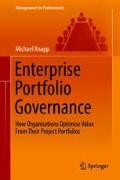Abstract
“The problem”, said the CFO of a large financial services organisation, “is that we’re spending a billion dollars a year on projects and I don’t know if we’re getting value for money”. This was something I had heard many times before. He continued, “and I’m not even sure we’re spending it on the right projects”.
Access this chapter
Tax calculation will be finalised at checkout
Purchases are for personal use only
Notes
- 1.
Australian companies are referenced as these formed the basis for the research under-pinning this book, however organisations and projects in Asia, Europe and North America were also studied, with few differences found between the nature and execution of projects across any region.
- 2.
I will use Australian dollars (AUD), ‘<Footnote ID=”Fn2”><Para ID=”Par27”>I will use Australian dollars (AUD), ‘$’ from this point forward.</Para></Footnote>#x2019; from this point forward.
- 3.
The term ‘silver bullet’ has been used with projects from at least 1979, and it was popularised by Fred Brooks in his paper “No Silver Bullet – Essence and Accident in Software Engineering” published in 1986. It refers to seeking one, all-encompassing solution to what we now refer to as ‘wicked problems’.
- 4.
I will focus on projects and project success here, and in Chap. 3 expand on how success can be defined for programs and portfolios.
- 5.
The Open Group Architecture Framework (TOGAF) is a set of frameworks covering a range of architecture components, such as Business, Data, Information, Network.
References
Davis, K. (2014). Different stakeholder groups and their perceptions of project success. International Journal of Project Management, 32, 189–201.
Denrell, J. (2003). Vicarious learning, undersampling of failure, and the myths of management. Organization Science, 14, 227–243.
Framework, D. (2017). The Disciplined Agile (DA) framework [Online]. Available: http://www.disciplinedagiledelivery.com/ [Accessed].
Gartner Inc. (2012). Why IT projects fail in government. Stamford: Gartner Inc.
Gereffi, G. H., Humphrey, J., & Sturgeon, T. (2005). The governance of global value chains. Review of International Political Economy, 12, 78–104.
Hope, J. F., & Fraser, R. (2003). Beyond budgeting: How you can break free from the annual performance trap. HBS: Boston.
KPMG International. (2017). KPMG’s International 2017 project management survey. Sydney: KPMG.
PricewaterhouseCoopers. (2004). Boosting business performance through programme and project management. Woluwedal: Pricewaterhouse Coopers.
Project Management Institute. (2013). Organizational project management maturity model. Newtown Square: PMI.
Project Management Institute. (2014). A guide to the program management body of knowledge. Newtown: PMI.
Project Management Institute. (2016). Pulse of the profession. Newtown Square: PMI.
PWC. (2012). Insights and trends: Current programme and project management practices. Connectedthinking.
Software, R. (2016). Scaled Agile Framework V4.0 (SAFe) [Online]. Available: http://www.scaledagileframework.com/ [Accessed].
Author information
Authors and Affiliations
Rights and permissions
Copyright information
© 2018 Springer Nature Singapore Pte Ltd.
About this chapter
Cite this chapter
Knapp, M. (2018). It’s Time to Change the Project Model. In: Enterprise Portfolio Governance. Management for Professionals. Springer, Singapore. https://doi.org/10.1007/978-981-10-7838-5_1
Download citation
DOI: https://doi.org/10.1007/978-981-10-7838-5_1
Published:
Publisher Name: Springer, Singapore
Print ISBN: 978-981-10-7837-8
Online ISBN: 978-981-10-7838-5
eBook Packages: Business and ManagementBusiness and Management (R0)

